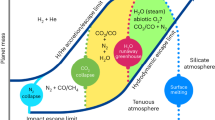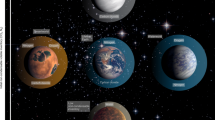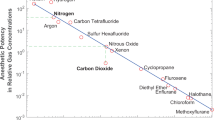Abstract
Theory and observation for the search for life on exoplanets via atmospheric ‘biosignature gases’ is accelerating, motivated by the capabilities of the next generation of space- and ground-based telescopes. The most observationally accessible rocky planet atmospheres are those dominated by molecular hydrogen gas, because the low density of H2 gas leads to an expansive atmosphere. The capability of life to withstand such exotic environments, however, has not been tested in this context. We demonstrate that single-celled microorganisms (Escherichia coli and yeast) that normally do not inhabit H2-dominated environments can survive and grow in a 100% H2 atmosphere. We also describe the astonishing diversity of dozens of different gases produced by E. coli, including many already proposed as potential biosignature gases (for example, nitrous oxide, ammonia, methanethiol, dimethylsulfide, carbonyl sulfide and isoprene). This work demonstrates the utility of laboratory experiments to better identify which kinds of alien environments can host some form of possibly detectable life.
This is a preview of subscription content, access via your institution
Access options
Access Nature and 54 other Nature Portfolio journals
Get Nature+, our best-value online-access subscription
$29.99 / 30 days
cancel any time
Subscribe to this journal
Receive 12 digital issues and online access to articles
$119.00 per year
only $9.92 per issue
Buy this article
- Purchase on Springer Link
- Instant access to full article PDF
Prices may be subject to local taxes which are calculated during checkout




Similar content being viewed by others
Data availability
We supplied the source data for Figs. 2 and 3, which you can find as supplementary files as well as at https://dspace.mit.edu/handle/1721.1/123824. The other data that support the plots within this paper and other findings of this study are available from the authors on request.
Change history
14 May 2020
A Correction to this paper has been published: https://doi.org/10.1038/s41550-020-1124-1
References
Ringwood, A. E. Origin of the Earth and Moon (Springer, 1979).
Elkins‐Tanton, L. T. & Seager, S. Ranges of atmospheric mass and composition of super‐Earth exoplanets. Astrophys. J. 685, 1237–1246 (2008).
Rogers, L. A., Bodenheimer, P., Lissauer, J. J. & Seager, S. Formation and structure of low-density exo-Neptunes. Astrophys. J. 738, 59 (2011).
Walker, J. C. G. Evolution of the Atmosphere (Macmillan, 1977).
Levi, A., Kenyon, S. J., Podolak, M. & Prialnik, D. H-Atmospheres of icy super-Earths formed in situ in the outer solar system: an application to a possible planet nine. Astrophys. J. 839, 111 (2017).
Pierrehumbert, R. & Gaidos, E. Hydrogen greenhouse planets beyond the habitable zone. Astrophys. J. Lett. 734, L13 (2011).
Hu, R., Seager, S. & Yung, Y. L. Helium atmospheres on warm Neptune- and sub-Neptune-sized exoplanets and applications to GJ 436b. Astrophys. J. 807, 8 (2015).
Stevenson, D. J. Life-sustaining planets in interstellar space? Nature 400, 32 (1999).
Kasting, J. F. in Treatise on Geochemistry 2nd edn, Vol. 6, 157–175 (Elsevier, 2013).
Zahnle, K. J., Gacesa, M. & Catling, D. C. Strange messenger: a new history of hydrogen on Earth, as told by xenon. Geochim. Cosmochim. Acta 244, 56–85 (2019).
De Wit, J. et al. Atmospheric reconnaissance of the habitable-zone Earth-sized planets orbiting TRAPPIST-1. Nat. Astron. 2, 214–219 (2018).
Diamond-Lowe, H., Berta-Thompson, Z., Charbonneau, D. & Kempton, E. M.-R. Ground-based optical transmission spectroscopy of the small, rocky exoplanet GJ 1132b. Astron. J. 156, 42 (2018).
Seager, S. & Sasselov, D. D. Theoretical transmission spectra during extrasolar giant planet transits. Astrophys. J. 537, 916–921 (2000).
Marois, C. et al. Direct imaging of multiple planets orbiting the star HR 8799. Science 322, 1348–1352 (2008).
Seager, S. & Deming, D. Exoplanet atmospheres. Annu. Rev. Astron. Astrophys. 48, 631–672 (2010).
Madhusudhan, N., Knutson, H., Fortney, J. J. & Barman, T. in Protostars and Planets VI (eds Beuther, H. et al.) 739–762 (University of Arizona Press, 2014).
Balch, W. E., Fox, G. E., Magrum, L. J., Woese, C. R. & Wolfe, R. S. Methanogens: reevaluation of a unique biological group. Microbiol. Rev. 43, 260–296 (1979).
Peters, V., Janssen, P. H. & Conrad, R. Efficiency of hydrogen utilization during unitrophic and mixotrophic growth of Acetobacterium woodii on hydrogen and lactate in the chemostat. FEMS Microbiol. Ecol. 26, 317–324 (1998).
Pajusalu, M., Borlina, C. S., Seager, S., Ono, S. & Boask, T. Open-source sensor for measuring oxygen partial pressures below 100 microbars. PLoS ONE 13, e020667 (2018).
Kaye, G. W. C. & Laby, T. H. Tables of Physical and Chemical Constants (Longman, 1986).
Pavlov, A. A. & Kasting, J. F. Mass-independent fractionation of sulfur isotopes in Archean sediments: strong evidence for an anoxic Archean atmosphere. Astrobiology 2, 27–41 (2002).
Buzas, Z. S., Dallmann, K. & Szajani, B. Influence of pH on the growth and ethanol production of free and immobilized Saccaromyces cerevisiae cells. Biotechnol. Bioeng. 34, 882–884 (1989).
Waldbauer, J. R., Newman, D. K. & Summons, R. E. Microaerobic steroid biosynthesis and the molecular fossil record of Archean life. Proc. Natl Acad. Sci. USA 108, 13409–13414 (2011).
Davies, B. S. J. & Rine, J. A role for sterol levels in oxygen sensing in Saccharomyces cerevisiae. Genetics 174, 191–201 (2006).
Takishita, K. et al. Lateral transfer of tetrahymanol-synthesizing genes has allowed multiple diverse eukaryote lineages to independently adapt to environments without oxygen. Biol. Direct 7, 5 (2012).
Gregory, S. P., Barnett, M. J., Field, L. P. & Milodowski, A. E. Subsurface microbial hydrogen cycling: natural occurrence and implications for industry. Microorganisms 7, 53 (2019).
Schaefer, L. & Fegley, B.Jr Chemistry of atmospheres formed during accretion of the Earth and other terrestrial planets. Icarus 208, 438–448 (2010).
Levi, A., Sasselov, D. & Podolak, M. Structure and dynamics of cold water super-Earths: the case of occluded CH4 and its outgassing. Astrophys. J. 792, 125 (2014).
Jo, J. Y. et al. Acute respiratory distress due to methane inhalation. Tuberc. Respir. Dis. 74, 120–123 (2013).
Shapiro, R. Origins: A Skeptic’s Guide to the Creation of Life on Earth (Bantam Dell Pub. Group, 1987).
Benner, S. A. et al. When did life likely emerge on Earth in an RNA‐first process? ChemSystemsChem 2, e1900035 (2020).
Seager, S., Bains, W. & Hu, R. Biosignature gases in H2-dominated atmospheres on rocky exoplanets. Astrophys. J. 777, 95 (2013).
Linstrom, P. J. & Mallard, W. G. The NIST Chemistry Webbook: a chemical data resource on the Internet. J. Chem. Eng. Data 46, 1059–1063 (2001).
Cox, C. S. The survival of Escherichia coli in nitrogen atmospheres under changing conditions of relative humidity. Microbiology 45, 283–288 (1966).
Acknowledgements
We thank A. Babbin for use of his laboratory and S. Smirga for assistance. We thank M. Slabicki and C. de Boer for providing us with a sample of yeast Saccharomyces cerevisiae S288C. We also thank J. Petkowska-Hankel for help with Fig. 1 and Z. Zhan for Fig. 4. Seed funding for this work came from the Templeton Foundation Grant ‘The Alien Earths Initiative’, ID 43769. Funding for this work came from the MIT Professor Amar G. Bose Research Grant Program.
Author information
Authors and Affiliations
Contributions
S.S. conceived the original idea and wrote the paper with the help of J.J.P. and M.P. M.P. designed and implemented the experimental set-up. S.S. and M.P. planned the experiments with the help of J.J.P. J.H. and M.P. performed the experiments with the help of J.J.P. All authors analysed the data.
Corresponding author
Ethics declarations
Competing interests
The authors declare no competing interests.
Additional information
Publisher’s note Springer Nature remains neutral with regard to jurisdictional claims in published maps and institutional affiliations.
Supplementary information
Supplementary Information
Supplementary Materials and Methods, Figs. 1–3 and Tables 1–3.
Source data
Source Data Fig. 2
E. coli culture OD measurement data.
Source Data Supplementary Fig. 2
Oxygen partial pressures in E. coli experiments
Source Data Fig. 3
Composite photos of yeast cells in hemocytometer used for cell counting.
Source Data Fig. 3
Yeast hemocytometer cell counting data.
Source Data Supplementary Fig. 3
Oxygen partial pressures in yeast experiments.
Rights and permissions
About this article
Cite this article
Seager, S., Huang, J., Petkowski, J.J. et al. Laboratory studies on the viability of life in H2-dominated exoplanet atmospheres. Nat Astron 4, 802–806 (2020). https://doi.org/10.1038/s41550-020-1069-4
Received:
Accepted:
Published:
Issue Date:
DOI: https://doi.org/10.1038/s41550-020-1069-4
This article is cited by
-
Defending Earth’s terrestrial microbiome
Nature Microbiology (2022)
-
Potential long-term habitable conditions on planets with primordial H–He atmospheres
Nature Astronomy (2022)
-
Microbial oxidation of atmospheric trace gases
Nature Reviews Microbiology (2022)



